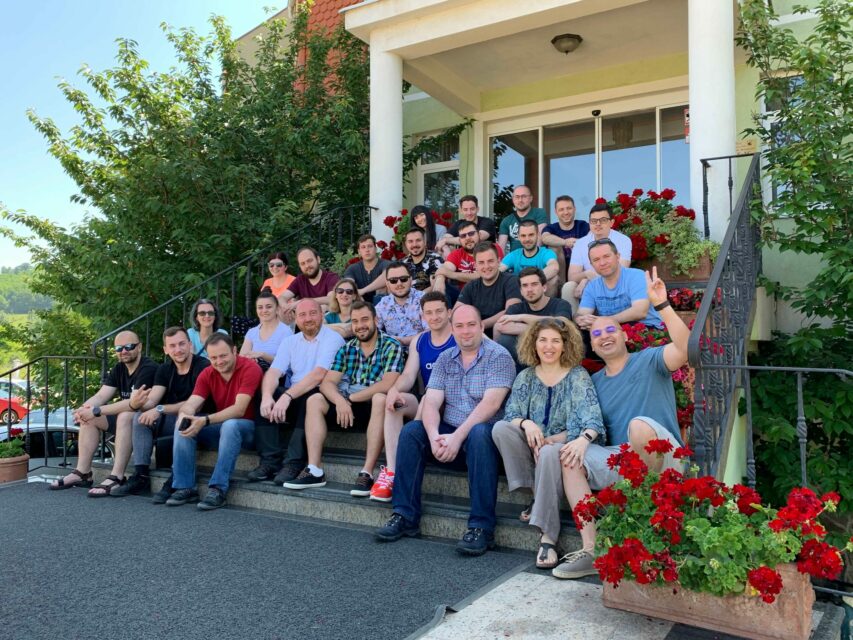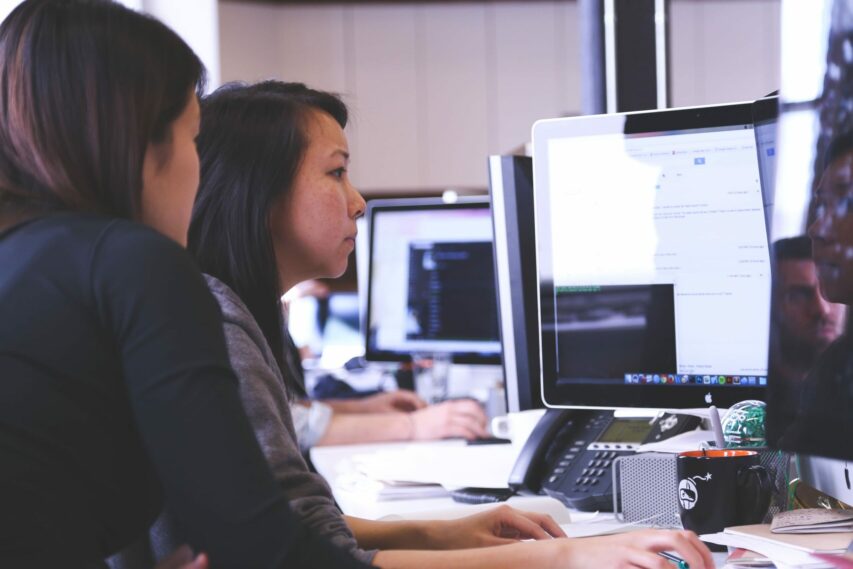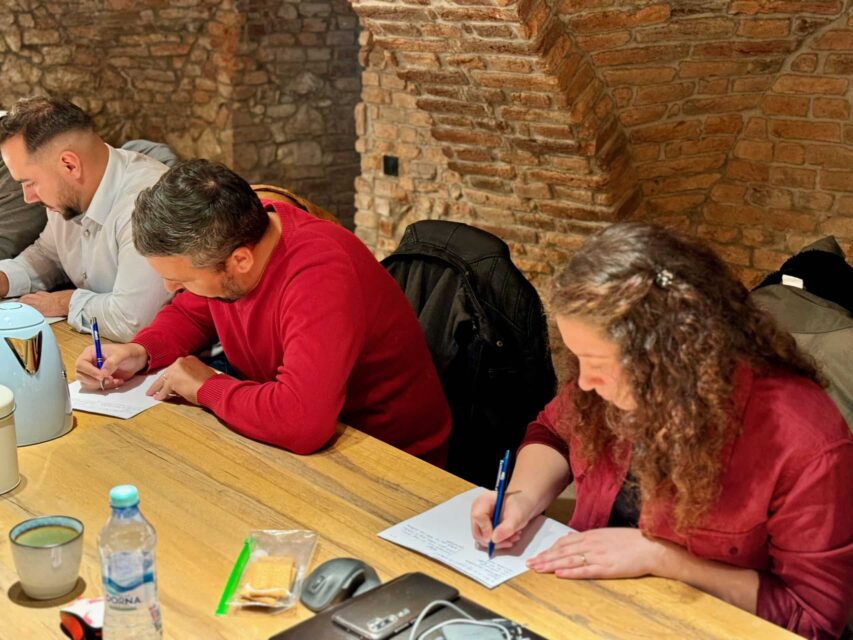Workshop –
yoga at the office
Office work at the computer for at least 8 hours a day, can affect your health. If you’re already experiencing pain in the neck, shoulders, legs or eyes, is good to know that there are yoga techniques that can help to eliminate some of the negative effects that this type of work has on your health. Yoga exercises which I recommend, target tense areas, but also help to calm the mind. Even a short session of practical yoga techniques is very beneficial.
1 Rolling head
You can practice this yoga technique seated or standing, with the body straight and eyes closed (it helps to better introspection and relaxation). Slowly turn your head from left to right (clockwise) by focusing on the neck. Repeat the movement in reverse the same number of times. Upon completion, you will perceive excellent vibration, slight warmth in the channel, mental activation, and transparency.

2 Sudden head movements.
Seated or standing, with the body straight and eyes closed (it helps to better introspection and relaxation), twist the head sharply to the left around a vertical axis twice, then right all twice, left-back twice, and right-back twice. Finally, go back head twice, around a horizontal axis. The entire cycle is repeated at least five times. The movements are suddenly in quick succession. Upon completion, you will perceive a slight vibration in the neck, excellent training of subtle energies in the head, activation of latent mental potential, clarity, and detachment. It is essential to focus on the correctness of the posture when exercising the recommended yoga postures.

3 Swinging head.
Seated or standing, with the body straight and eyes closed, swing your head left and right, about a horizontal axis. Try to speed up gradually. Repeat the cycle at least ten times. Upon completion, you will realize the free flow of subtle energies in the neck, dynamic attention, and clarity, with the rest being the unification of mind, a state of harmony.
4 Twist back.
When you’re sitting, vertebral discs support the weight three times higher than when standing up, which means that problems can occur at any time at their level, often accompanied by pain. What to do? Twist your spine. Turn to the left. Place your left hand behind the seat to amplify the twist. Hold the position for 5 to 8 breaths, then come back and repeat the posture right.
5 Shoulder
Sitting on a chair, lift going back and sternum. Raise your right hand and bend the elbow. With your left hand behind your back, try to catch your right hand. Hold this position for 2 3 minutes and then repeat the movement but reversing hands. This exercise mobilizes shoulder and elbow joints, aligning the spine and giving inner blossoming and harmonization. It also strengthens the muscles of the chest.

6 Feet
If you have a sedentary job that keeps you glued to your seat for several hours a day, you will soon face inconvenience in the lower back, hips, and butt. Fortunately, with minimal effort, you can help eliminate the harmful effects of a long seat. Here are two practical yoga exercises! Place your left foot on the right knee, leaving your right leg free. Keep your back straight. Lean forward for a deeper stretch. After five breaths, change the position of the feet. Shoes off, and put your left foot (lying) on the desk. Then stretch your arms straight up and, with them, the trunk. Next, lean slightly toward the front and exhale; relax the back muscles and the back legs so you can get you’re had as close to the knee as possible. Bending will be first in the hip joint, your back as straight as possible. The hands must touch the left foot (or, at least, the ankle). After five breaths, change the position of the feet. Both exercises energize feet, increase vitality, and loosen the lower back, leading to inner regeneration and will quickly remove fatigue.
7 Stretch backbone
Spread your legs at a distance of about twice shoulder width with feet obliquely. Let yourself down as much as you can, exhaling through your mouth. Breathe in through your nose and then, deeply and completely, raise the trunk. Remember the air and immediately place palms on the thighs, even the angle between the thighs.
The elbows should be stretched. You can make slight twists that will help to increase the distance between the ribs and spine pushing. The exercise is unique in the recess and energizing of the body of the sciatic nerve. It confers flexibility.

8 Back
Back and chest muscles are tensed after a day at work while bent over the keyboard. To correct posture and alleviate back muscles, stand upright with your feet shoulder-width apart. Go hands parallel overhead and let yourself back slightly, pushing way ahead of your pelvis. Traces the top of hands or stays with eyes closed, relaxing the body. The position is ideal for releasing the tension in your back and lower back but has a therapeutic role in the case of fatigue and anxiety.
9 Aromatherapy
The best remedy for anxiety, stress, and mental fatigue is the volatile oil of lemon. Its therapeutic properties are incredibly numerous: tonic for the nervous system, reduces stress, helps in depression, protects against infection, immune-stimulant, it helps concentration, and has rejuvenating properties. Use oil applied topically to the skin, below the nose, two times a day, or choose to put a few drops in the palm and then do inhalations. The oil is not recommended for pregnant women or nursing mothers. Avoid sun exposure if you apply lemon oil onto your skin due to its photosensitizing action.
“…Yoga with Jody helps me deal with my work stress so much better, that even my colleagues have noticed a change in how I handle my stress and my attitude at work.”
— JJ D.
10 Breathe deeply!
Breathe in an area with clean air, at least during lunch. Mental anxiety is most often caused by the fact that you worry too much, and this creates a lot of tension. Here is a simple breathing exercise that helps to oxygenate your blood, raise your lung capacity, and eliminate toxins from the body, but primarily to get your mind off worries. You can do this exercise seated. Locate the first three parts where you feel the breath: the abdomen, bottom, and top of the lungs. You can put your left hand on the intercostal area and your right hand on the stomach. Do not force your breath. Inhale deeply through your nose, only abdominal, so only your right hand can move, inflating the abdomen. Remember the air for a few seconds and then expire on the mouth. Let it be circular breathing. Do this ten times and then breathe normally. You feel that you are calmer, more confident, and more relaxed.
11 Eye yoga exercises
If you spend a lot of time in front of a monitor, not only can your face be quite tense (without realizing it), but the optic nerve (which transmits images to the brain) tires. What to do? Here are two excellent yoga exercises:
- Conscientiousness does not relieve you of obstacles but helps to overcome them.
- Sit on the chair without moving no other part of the body, and rotate your gaze clockwise, imagining that you look at a large clock on the line at 12, 3, 6, 9, and again at 12. Repeat this exercise five times in both directions. If you feel your eyes are tired, do the palming technique. Cover your eyes closed with the palms of your hands without pressuring your eyeballs. For good energizing, and refreshing vision, rub your hands apart until you feel that heat.
- Standing with the body straight, let the head back relax. Orient looks to the root of the nose. Eye muscles must be completely relaxed. Hold the position for 3-5 minutes. At the first signs of fatigue, perform palming technique outlined above. Upon completion, you’ll realize refreshing eye movement, magnification eyepiece magnetism, dynamic attention, and expanded clarity.
12 Meditate at the office
Meditation can be an excellent source to eliminate stress. Just sit quietly and close your eyes. You will immediately begin to calm your mind. Meditation is awareness of what it is today. Nothing more, nothing less, just what it is. It means being aware of what is already happening now. It is called “consciousness-witness,” like watching a film with images like menus in front of you. Thoughts come and go. Do not try to capture any idea and create a story from it. Don’t force evil thoughts to go away. Just let them come and go. This is Vipassana – meditation without an object. Meditation lowers blood pressure and calms the nervous system. It induces calm, awakens intuition, and increases concentration. The cumulative effects will continue to influence your thoughts throughout the day. Ten minutes of meditation or deep relaxation equals two hours of sleep!!!
- Conscientiousness does not relieve you of obstacles but helps to overcome them.
- Posture is a simultaneous endeavor of body and soul vibrating in unison with the infinitude.
- Go as often as you understand beings, phenomena, and things, loving them. If you manage little or much, you will be the winner because you will enrich inwardly by this development.
- As long as the cause lasts, the effect lasts for good and worse.
- The effect disappears faster or slower by eradicating the cause.



